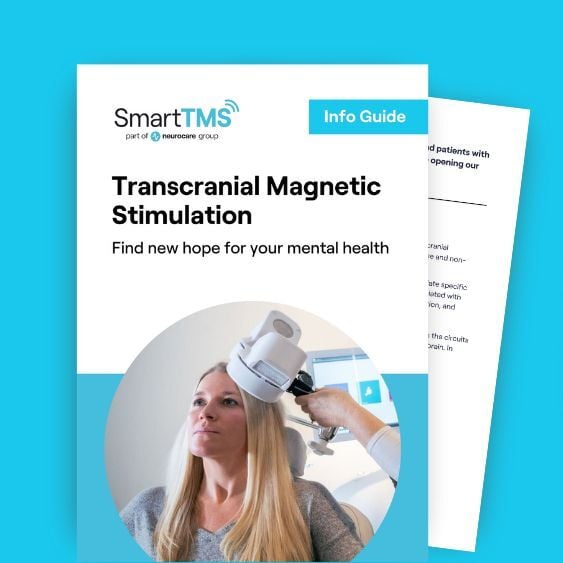Transcranial Magnetic Stimulation: A Promising Intervention for Premenstrual Dysphoric Disorder (PMDD)
August 6, 2025 - Smart TMS

At Smart TMS, we are always striving to improve our patients’ outcomes. We consult the latest research and implement it into our service. At the recent CTMSS conference, the latest TMS research event, we explored groundbreaking studies comparing traditional treatments with TMS for depression, anxiety, and mood disorders in women. One such study examined the potential of TMS in treating Premenstrual Dysphoric Disorder (PMDD), which we summarise below.
PMDD Background
Premenstrual Dysphoric Disorder (PMDD) is a severe form of premenstrual syndrome (PMS), causing significant irritability, depression, or anxiety in the week or two before menstruation. Affecting 2-8% of women (Gehlert, 2009), PMDD is classified as a cyclical depressive disorder in the DSM-V, characterised by emotional shifts, mood swings, irritability, and various physical symptoms. Unfortunately, many women with PMDD do not respond well to conventional treatments like antidepressants, oral contraceptives, psychotherapy, surgical interventions, or lifestyle changes.
Women with PMDD are more likely to experience mood disturbances due to genetic factors, heightened immune activation, and chronic stress. Research suggests that fluctuations in estrogen and progesterone interact with neurotransmitters such as serotonin and dopamine—chemicals crucial to mood regulation. These hormonal changes, especially when combined with stress or a history of mood disorders, increase susceptibility to PMDD symptoms.
Recent studies have identified significant changes in brain structures like the amygdala and hippocampus in women with PMDD. These changes are influenced by hormonal fluctuations and affect emotional regulation. Disruptions in brain network connectivity, particularly involving the temporal lobe, further support the neurological basis of PMDD (Long et al., 2022).
The Potential of TMS for Women’s Mental Health
Transcranial Magnetic Stimulation (TMS) is a non-invasive neuromodulation therapy used to treat various treatment-resistant mental health conditions. TMS for depression has been extensively researched and validated, with protocols like repetitive TMS (rTMS) and intermittent theta-burst stimulation (iTBS) demonstrating efficacy.
Given the symptomatic overlap between PMDD and major depressive disorder, TMS for women’s mood disorders—including PMDD—represents an exciting area of clinical exploration. TMS offers a drug-free alternative for women who do not respond to traditional treatments, with additional research exploring its potential in conditions like TMS for postnatal depression and anxiety.
The Pilot Study on TMS for PMDD
A recent pilot study investigated the use of TMS, specifically intermittent theta-burst stimulation (iTBS), in 17 women who had experienced PMDD symptoms for over a year. Participants completed the Daily Record of Severity of Problems (DRSP) for three months, with TMS treatment administered during the third month. Treatment was strategically scheduled during the late luteal phase of their menstrual cycle, a period when PMDD symptoms are most pronounced.
Each participant underwent daily 10-minute sessions of prolonged intermittent TBS (piTBS) over five consecutive days, targeting the left dorsolateral prefrontal cortex (DLPFC)—a region linked to mood regulation and frequently targeted in TMS treatments for depression and anxiety.
The study revealed a significant reduction in PMDD symptoms across all domains. This suggests that TMS for PMDD could serve as an effective therapeutic option for women who have exhausted other treatments.
Additional Research on TMS for Hormonal Mood Disorders
Emerging research has also linked PMDD to disrupted excitatory/inhibitory (E/I) balance in the visual cortex, particularly during the luteal phase. A study by Manyukhina et al. (2022) suggests that TMS may help restore this balance by modulating cortical excitability, offering further potential in addressing PMDD symptoms through targeted interventions during critical phases of the menstrual cycle.
Furthermore, Riddle et al. (2022) examined the impact of transcranial alternating current stimulation (tACS) on prefrontal neural activity in PMDD. Findings revealed phase-specific neural modulation, reinforcing the importance of timing in brain stimulation therapies like TMS and tACS. These insights also have implications for TMS in postnatal depression, where hormonal shifts similarly impact mood regulation.
Conclusion: TMS as a Holistic Treatment for Women’s Mental Health
The pilot study on TMS for PMDD adds to the growing body of evidence supporting TMS for women’s mental health, including TMS for depression, TMS for anxiety, and TMS for postnatal depression. By targeting neural circuits affected by hormonal fluctuations, TMS offers a novel, non-pharmacological intervention that can significantly improve the quality of life for women suffering from mood disorders.
Ongoing research into the timing and optimisation of TMS protocols will be crucial in refining its efficacy for PMDD and other hormone-related mood disorders. At Smart TMS, we remain committed to pioneering evidence-based treatments that deliver real-world benefits to our patients.
References
- Barth C, Villringer A, Sacher J. Sex hormones affect neurotransmitters and shape the adult female brain during hormonal transition periods. Front Neurosci. 2015;9:37. doi:10.3389/fnins.2015.00037.
- Gehlert, S., Song, I. H., Chang, C. H., & Hartlage, S. A. (2009). The prevalence of premenstrual dysphoric disorder in a randomly selected group of urban and rural women. Psychological medicine, 39(1), 129-136.
- Long, J., Wang, Y., Liu, L., & Zhang, J. (2022). The prominent role of the temporal lobe in premenstrual syndrome and premenstrual dysphoric Disorder: evidence from multimodal neuroimaging. Frontiers in Psychiatry, 13. https://doi.org/10.3389/fpsyt.2022.954211
- Manyukhina, V. O., Orekhova, E. V., Prokofyev, A. O., Obukhova, T. S., & Stroganova, T. A. (2022b). Altered visual cortex excitability in premenstrual dysphoric disorder: Evidence from magnetoencephalographic gamma oscillations and perceptual suppression. PLoS ONE, 17(12), e0279868. https://doi.org/10.1371/journal.pone.0279868
- Riddle, J., Rubinow, D. R., & Frohlich, F. (2022). Effect of tACS on prefrontal neural activity is menstrual phase dependent in patients with premenstrual dysphoric disorder. Brain Stimulation, 15(5), 1088–1090. https://doi.org/10.1016/j.brs.2022.07.052










